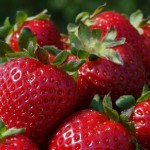Written by John Katterjohn
According to the media, edible gardens are big this year. Believe it or not, incorporating edible plants into the ornamental landscape can improve your garden aesthetics and function. And, if you are an avid gardener, it can also add a lot of fun. How cool is it to stroll through your yard and pick something fresh to eat for dinner? I think that adds some great personal satisfaction as well.
The obvious picture of an edible garden is simply a plot of ground dedicated solely to vegetables, a strawberry patch, a few rows of berry shrubs, and an orchard. This type of garden is geared strictly to production, canning, and perhaps truck farming. Let’s face it, unless one is retired or a professional truck farmer, there is not enough time and/or energy to invest in this type of labor intensive activity.
So, what can we do to enjoy some home grown fruits and vegetables and not make it burdensome? The answer is, incorporate fruits and vegetables into the ornamental garden. Many edible plants are quite ornamental as well as functional. Some examples are peppers, rhubarb, chard, herbs, kale, flowering annuals and perennials, gooseberry, strawberry, and fruit trees just to name a few. There are several lists available on the internet.
Edible plants in the landscape serve several functions. Obviously they provide fresh, healthy, and inexpensive sources of food (if you don’t include your time in calculating actual cost). Many provide great color and texture that will work very well in the landscape. Incorporate fruiting plants into perennial borders. Blueberry shrubs have excellent fall color. There are also several plants that provide edible flowers that go well with salads. Nasturtium, viola, and Calendula are some great examples. Consult the internet for more ideas.
Strawberry plants make a beautiful groundcover and will tolerate a little shade. Gooseberry is a wonderful shrub that is not only ornamental in value but also lends itself to heavy fruiting. How about some gooseberry pie? Squash, tomato, and pumpkin can be trained to grow on fencing. Herbs, such as lavender and boxwood basil, make excellent hedges that can satisfy the need for formal plantings. Thyme is a good groundcover that can be used to fill in cracks in modular paving. A patch of corn or sunflower can make a great screen to block an ugly view.
Here are a few culture tips. Always cut fresh flowers and vegetables for immediate use, the flavor is always best. Rinse the vegetables in salted water to remove any insects and slugs. If it is necessary to use pesticides and fertilizers, use organic products that are safe to use on plants for human consumption. Always read the label thoroughly before use.
 So, incorporate your edible plants into the general landscape. View them in an ornamental and functional way. Try organic methods of caring for plants. Flowering plants will attract pollinators and many beneficial insects. Have fun with plant diversity, it makes for a healthy place to live. And, don’t forget containers. Edible plants make great container gardens that can be moved around, placed in prominent locations, and even moved indoors for winter enjoyment. Oh yum, I’m still thinking about that tart gooseberry pie.
So, incorporate your edible plants into the general landscape. View them in an ornamental and functional way. Try organic methods of caring for plants. Flowering plants will attract pollinators and many beneficial insects. Have fun with plant diversity, it makes for a healthy place to live. And, don’t forget containers. Edible plants make great container gardens that can be moved around, placed in prominent locations, and even moved indoors for winter enjoyment. Oh yum, I’m still thinking about that tart gooseberry pie.
